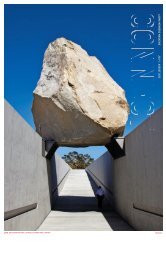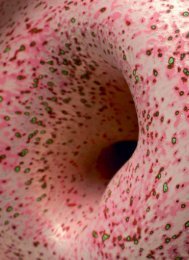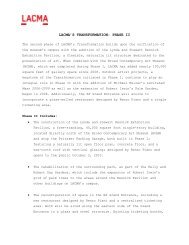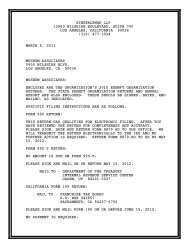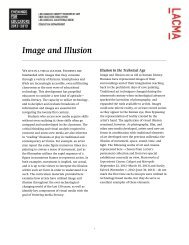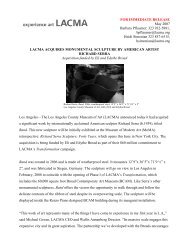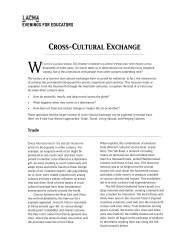Charles White booklet - Los Angeles County Museum of Art
Charles White booklet - Los Angeles County Museum of Art
Charles White booklet - Los Angeles County Museum of Art
You also want an ePaper? Increase the reach of your titles
YUMPU automatically turns print PDFs into web optimized ePapers that Google loves.
SWAP<br />
LACMA Exhibition Project at <strong>Charles</strong> <strong>White</strong> Elementary School<br />
Edited by Susan H<strong>of</strong>fmann
Published by the Education Department <strong>of</strong> the <strong>Los</strong> <strong>Angeles</strong> <strong>County</strong> <strong>Museum</strong> <strong>of</strong> <strong>Art</strong>.<br />
© 2009 <strong>Museum</strong> Associates | lacma. All rights reserved.<br />
The SWAP installation and this publication were made possible through the Anna H.<br />
Bing Children’s <strong>Art</strong> Education Fund.<br />
Education programs at the <strong>Los</strong> <strong>Angeles</strong> <strong>County</strong> <strong>Museum</strong> <strong>of</strong> <strong>Art</strong> are supported in part by<br />
the City <strong>of</strong> <strong>Los</strong> <strong>Angeles</strong> Department <strong>of</strong> Cultural Affairs and the William Randolph Hearst<br />
Endowment Fund for <strong>Art</strong>s Education.
Contents<br />
4<br />
8<br />
12<br />
28<br />
44<br />
62<br />
foreword<br />
preface<br />
students | art at school<br />
artists | mark bradford & ruben ochoa<br />
museum educators | lacma in the community<br />
acknowledgments
lacma director Michael Govan and artist Ruben<br />
Ochoa at the opening <strong>of</strong> SWAP.<br />
f o r e w o r d<br />
Educational programming is integral to the mission <strong>of</strong> the <strong>Los</strong> <strong>Angeles</strong><br />
<strong>County</strong> <strong>Museum</strong> <strong>of</strong> <strong>Art</strong>. Because lacma is encyclopedic in scope, with<br />
collections from all cultures, from ancient times to the present, we<br />
are able to use art as a window into the history <strong>of</strong> the world as well as<br />
the world we live in today.<br />
Every day, lacma brings students to the museum for tours, classes,<br />
and art camps, and our student membership program, <strong>Art</strong>s for Nex-<br />
Gen lacma, boasts ninety-five thousand members. Through the<br />
Evenings for Educators program, we provide teachers with curriculum<br />
materials for arts education. We also bring the arts to the schools via<br />
the Maya Mobile and the Ancient World Mobile.<br />
SWAP, the project presented in this publication, belongs to that<br />
tradition <strong>of</strong> service and extends it, too. Our collaboration with <strong>Charles</strong><br />
f o r e w o r d | 4
<strong>White</strong> Elementary School is part <strong>of</strong> the museum’s ambitious <strong>Art</strong> Programs<br />
with the Community: LACMA On-Site, a four-year effort that allocates<br />
a million dollars per year to an in-depth arts curriculum in and<br />
around <strong>Los</strong> <strong>Angeles</strong> Unified School District 4. This endeavor is made<br />
possible by the Anna H. Bing lacma Trust, bequeathed by founding<br />
trustee Anna Bing Arnold, who long cherished education as an<br />
essential function <strong>of</strong> this museum.<br />
The wonderful thing about SWAP was not only involving young<br />
students in art but allowing them to interact with artists. Mark Bradford<br />
and Ruben Ochoa, working with lacma educators and curators<br />
and with teachers at <strong>Charles</strong> <strong>White</strong>, helped these students to engage<br />
with their own community and everyday lives in new ways. I am<br />
f o r e w o r d | 6
delighted to call your attention to this unique and successful program.<br />
And I am proud to have participated, with my colleagues, in an imaginative<br />
collaboration with members <strong>of</strong> our community.<br />
michael govan<br />
ceo and Wallis Annenberg Director<br />
<strong>Los</strong> <strong>Angeles</strong> <strong>County</strong> <strong>Museum</strong> <strong>of</strong> <strong>Art</strong>
p r e fac e<br />
The <strong>Charles</strong> <strong>White</strong> project was funded through an extraordinary endowment<br />
from former trustee Anna Bing Arnold. Working with her<br />
family, we developed a comprehensive program to support education<br />
through a multiyear partnership with local public schools. The initiative,<br />
called <strong>Art</strong> Programs with the Community: LACMA On-Site, has helped<br />
us reach nearly sixty thousand students, teachers, and members <strong>of</strong> the<br />
community annually since the fall <strong>of</strong> 2006.<br />
These funds allowed us to imagine new methods to serve the<br />
schoolchildren and families <strong>of</strong> <strong>Los</strong> <strong>Angeles</strong>, particularly those students<br />
enrolled in District 4 <strong>of</strong> the <strong>Los</strong> <strong>Angeles</strong> Unified School District (lausd).<br />
With Richard Alonzo, superintendent <strong>of</strong> District 4, we explored ways<br />
to encourage his students to consider a future in the arts. This was<br />
especially timely because the lausd plans to open a new high school<br />
p r e f a c e | 8
for the arts in District 4. Mr. Alonzo suggested a program at <strong>Charles</strong><br />
<strong>White</strong> Elementary School, which sits on the former campus <strong>of</strong> Otis<br />
<strong>Art</strong> Institute and includes a dedicated art gallery.<br />
Our immediate thought was to commission an artist or artists to<br />
create a project involving the students as well as the surrounding<br />
neighborhood. I worked with Toby Tannenbaum, former director <strong>of</strong><br />
Education at lacma, and Elizabeth Gerber, the museum’s manager <strong>of</strong><br />
School and Teacher Programs, to identify artists who might participate.<br />
We chose Mark Bradford and Ruben Ochoa because <strong>of</strong> how important<br />
community is to their work.<br />
This publication chronicles the results <strong>of</strong> our project. I hope it<br />
will inspire museum educators to connect their own institutions,<br />
local artists, and schoolchildren in meaningful ways.<br />
jane burrell<br />
Vice President, Education and Public Programs<br />
<strong>Los</strong> <strong>Angeles</strong> <strong>County</strong> <strong>Museum</strong> <strong>of</strong> <strong>Art</strong>
“¡Mándala!” “¡Estoy listo!”<br />
s t u d e n t s | <strong>Art</strong> at School<br />
“Class, let’s line up!”<br />
Teachers and their young students know what this means. Textbooks<br />
close. Paper and pencils are stored away. It’s time to leave the classroom<br />
and go outside. At <strong>Charles</strong> <strong>White</strong> Elementary School, the formation<br />
<strong>of</strong> sometimes giggling, <strong>of</strong>ten rambunctious children snakes down<br />
hallways and up stairs before coming to the heavy double doors that<br />
open to the playground.<br />
“¡Mándala!” Kick it! “¡Estoy listo!” I’m ready! Soccer games fuel the<br />
passions <strong>of</strong> some students, most <strong>of</strong> whom speak Spanish as their first<br />
language. Others jump rope to the song <strong>of</strong> “Do the waterfall!” Their<br />
small playground is surrounded by the tall buildings <strong>of</strong> the <strong>Los</strong> <strong>Angeles</strong><br />
neighborhood called Mac<strong>Art</strong>hur Park. Glass and steel <strong>of</strong>fice buildings<br />
s t u d e n t s | 1 2
stand next to hotels built in the 1920s and 1930s whose imposing<br />
sculptures and intricately carved exteriors mask their new use as lowincome<br />
housing that some students call home. The streets surrounding<br />
the heart <strong>of</strong> their neighborhood—a sparkling lake nestled into a<br />
large park—are crowded with check-cashing stores and small markets.<br />
Colorful images painted on exterior walls advertise merchandise or<br />
services <strong>of</strong>fered, as do lettered signs in English, Spanish, and Korean<br />
that hang from metal fences and above doorways.<br />
This neighborhood—so familiar to <strong>Charles</strong> <strong>White</strong> students—became<br />
the focus <strong>of</strong> SWAP, an exhibition developed by the <strong>Los</strong> <strong>Angeles</strong><br />
<strong>County</strong> <strong>Museum</strong> <strong>of</strong> <strong>Art</strong> in collaboration with <strong>Los</strong> <strong>Angeles</strong> artists Mark<br />
Bradford and Ruben Ochoa. Between November 2007 and June 2008,<br />
students discovered a new reason to eagerly anticipate their teachers’<br />
instruction “Line up!” They pushed open the double doors to the play-<br />
“Line up!”
ground, crossed its concrete surface, tumbled down two sets <strong>of</strong> outdoor<br />
stairs (or, for the daring, slid down the metal hand railings) until<br />
they reached another set <strong>of</strong> double doors. Elmer Ray, the security <strong>of</strong>ficer,<br />
welcomed the children to a gallery installed to look remarkably<br />
like Mac<strong>Art</strong>hur Park.<br />
“Is that really you?” a student asked. And yes, the picture on the<br />
oversized awning was that <strong>of</strong> Mr. Ray. The awning was nearly identical<br />
to one that hangs above the entrance to a swap meet near the school,<br />
a place where many <strong>of</strong> the children and their families shop.<br />
“We wanted to give the kids permission,” said artist Mark Bradford,<br />
“to think about art as not necessarily being something outside <strong>of</strong> their<br />
vocabulary, outside <strong>of</strong> their understanding, outside <strong>of</strong> their possibility.”<br />
s t u d e n t s | 1 4
Throughout the three rooms <strong>of</strong> the gallery, children repeatedly<br />
encountered familiar elements—pictures <strong>of</strong> cleaning products were<br />
painted on the gallery walls by Ricardo Matamoros, who also paints<br />
pictures and signs on buildings around Mac<strong>Art</strong>hur Park. Shoes were<br />
displayed on plastic shelves hung from the very kind <strong>of</strong> slat board<br />
commonly used at swap meets. In one section <strong>of</strong> the exhibition, students<br />
found framed artwork they or their schoolmates had made.<br />
These were hung from wire display shelving, identical to those the
lacma educator Franky Kong and <strong>Charles</strong> <strong>White</strong> teacher Jaclynn Valenzuela discuss art with students in SWAP.
House Group, Mexico, Nayarit, 200 b.c.–a.d. 500. Maura Bendett, Fer-de-Lance, 1999.<br />
children see in nearby shops. Throughout the exhibition were examples<br />
<strong>of</strong> art from lacma’s collection: House Group made in Mexico (Nayarit)<br />
between 200 b.c. and a.d. 500, prints pulled in the 1960s by<br />
Kenneth Price, and Maura Bendett’s Fer-de-Lance, 1999, a favorite <strong>of</strong> the<br />
<strong>Charles</strong> <strong>White</strong> students.<br />
“I liked the glass art,” one student said.<br />
“It looked like there were butterflies on pieces <strong>of</strong> leaves,”<br />
said another.<br />
s t u d e n t s | 1 8<br />
“It looked like there were butterflies on pieces <strong>of</strong> leaves.”
“But is that really art?”<br />
“If my art hangs next to art from a museum, does that make it art?”<br />
During frequent visits to the exhibition, students developed skills<br />
<strong>of</strong> looking, describing, forming preferences, and, as fourth-grade<br />
teacher Paul Lowe noted, comparing different kinds <strong>of</strong> art. “I brought<br />
my students to the gallery as <strong>of</strong>ten as I could. The more we came, the<br />
more confidence the children showed in asking themselves and each<br />
other, ‘How is the art the same? How is it different?’ They really got<br />
their teeth into that discussion.”<br />
Another favorite question was “But is that really art?” Students<br />
were fascinated that the kind <strong>of</strong> sign painting they saw every day on<br />
buildings in the neighborhood could be included in an art exhibition.<br />
If their own art was on view, students wondered, “If my art hangs next<br />
to art from a museum, does that make it art?” But what challenged<br />
their notion <strong>of</strong> art more than anything else was the display <strong>of</strong> shoes<br />
installed by Ochoa and Bradford.
“The shoes were old school, old style,” said one student.<br />
“My sister wasn’t sure it was art,” said another.<br />
“But an artist made it,” countered yet another.<br />
“The shoes are art because they have lots <strong>of</strong> different designs and<br />
because people wear them,” concluded one student.<br />
If SWAP inspired this kind <strong>of</strong> critical thinking in students, it also<br />
allowed teachers to imagine new ways to incorporate the arts into<br />
their curriculum. In the <strong>Los</strong> <strong>Angeles</strong> Unified School District (lausd),<br />
teachers use the Open Court Reading (ocr) program for a majority <strong>of</strong><br />
the day. Each ocr unit is thematic and begins with what teachers call<br />
an opener. “We decided, as teachers,” Mr. Lowe said, “to use the exhibition<br />
to open our units. For example, one ocr theme is risks and consequences.<br />
We went into the gallery and looked at a work <strong>of</strong> art. What<br />
risks did the artist take? What were the consequences?”<br />
s t u d e n t s | 2 0
“My sister wasn’t sure it was art.”<br />
“But an artist made it.”<br />
One student pondered these very questions. He was attracted to the<br />
lacma work by the American artist Chaz Bojórquez, Ano Loco XIV92 Por<br />
Dios y Oro, 1992, which includes a section resembling lines <strong>of</strong> graffiti.<br />
The student considered the risks and consequences <strong>of</strong> making this<br />
kind <strong>of</strong> art. “Is it OK for me to make graffiti?” he asked Elmer Ray, the<br />
security <strong>of</strong>ficer. “No,” Mr. Ray responded, “not if you draw it on someone’s<br />
property. Put it in a special art journal. Then it’s no trouble.”<br />
Several weeks later, the boy returned to the gallery and proudly<br />
showed his journal to an admiring Mr. Ray.<br />
lacma educators and curators, working with Ochoa and Bradford,<br />
chose museum pieces that either explored the concept <strong>of</strong> community<br />
or were made by cultures the schoolchildren knew. “Looking at the<br />
lacma pieces like the House Group from Mexico or the fantastic animals<br />
in sculpture from Thailand, the students began to make links,”<br />
Chaz Bojórquez, Ano Loco XIV92 Por Dios y Oro, 1992 (detail).
Mr. Lowe noted. “‘Wow! These go all the way back to my ancestors?’<br />
The students started developing artistic heroes in their minds, people<br />
they could look up to from their own cultures.”<br />
<strong>Charles</strong> <strong>White</strong> Elementary School is unusual in having an art<br />
gallery. The gallery belonged to Otis College <strong>of</strong> <strong>Art</strong> and Design and became<br />
part <strong>of</strong> the <strong>Charles</strong> <strong>White</strong> campus when lausd acquired the<br />
property. But the school is not unique in its inclusion <strong>of</strong> arts education<br />
into its curriculum. Since 1999, lausd has been systematically introducing,<br />
or reintroducing, arts instruction into all <strong>of</strong> its more than<br />
eleven hundred schools. In Local District 4 <strong>of</strong> lausd, which includes<br />
<strong>Charles</strong> <strong>White</strong>, the push for arts instruction has a special focus. A new<br />
high school for the arts will open fall 2009. Richard Alonzo, superintendent<br />
<strong>of</strong> Local District 4, wants all elementary and middle school<br />
students in his district to be ready to enroll in the new high school for<br />
Students and lacma educators Lara Miller and<br />
S<strong>of</strong>ía Gutierrez discuss the inflated sculpture<br />
Dancing Popos (slang term for police) installed by<br />
Ruben Ochoa and the wall painting by neighborhood<br />
sign painter Ricardo Matamoros.<br />
s t u d e n t s | 2 2<br />
“‘Wow! These go all the way back to my ancestors?”
the arts, if they choose to. He realized he needed community partners,<br />
like lacma, to help him prepare his students and teachers.<br />
“Jane Burrell, the museum’s vice president <strong>of</strong> education and public<br />
programs, came to me with an idea,” said Mr. Alonzo. “‘What if we<br />
brought some <strong>of</strong> our collection into the gallery,’ she said, ‘and the students<br />
put their art side by side, so they could envision themselves as<br />
artists at a very early age? And what if we had contemporary artists<br />
they could interact with as well?’ I’d never heard <strong>of</strong> anything like this<br />
before. It was a phenomenal idea.”<br />
When children saw SWAP for the last time, in early June <strong>of</strong> 2008,<br />
and headed back across the playground to class, one paused to reflect.<br />
“I never imagined art could be about oven cleaners,” he said. “I think<br />
the art is really good. I wish I could keep it.” What the students did<br />
keep from the exhibition—which had been specially designed for<br />
<strong>Charles</strong> <strong>White</strong> Elementary School enrolled<br />
514 students in grades 1–5 during<br />
the 2007 | 2008 school year, 93 percent <strong>of</strong><br />
whom were Hispanic. A Title 1 school,<br />
<strong>Charles</strong> <strong>White</strong> addresses the needs <strong>of</strong><br />
low-income children: all qualify for free<br />
meals at school and nearly 75 percent receive<br />
English language instruction.<br />
<strong>Charles</strong> <strong>White</strong> belongs to Local District 4<br />
<strong>of</strong> the <strong>Los</strong> <strong>Angeles</strong> Unified School District,<br />
which includes a total <strong>of</strong> 8 districts<br />
and provides instruction to nearly<br />
700,000 students on its 1,190 school campuses.<br />
The lausd is the second largest<br />
public school district in the nation; only<br />
New York City serves more students.<br />
s t u d e n t s | 2 4
them and installed at their school—was the understanding that art<br />
can be something familiar that fits into their lives, as Bradford and<br />
Ochoa had hoped. The on-site exhibition also helped the students<br />
build the confidence to look at art, to explore its meaning and purpose,<br />
to listen to the differing opinions <strong>of</strong> classmates, and to imagine,<br />
as children so easily do, that they might already be artists. They also<br />
learned that it was fine to leave one question unanswered: Are those<br />
shoes really art?<br />
susan h<strong>of</strong>fmann<br />
Independent <strong>Art</strong> <strong>Museum</strong> Educator<br />
I believe students in underrepresented<br />
areas not only need quality instruction<br />
and opportunities in the arts, but they<br />
also need to understand that everyone is<br />
an artist and everyone has the capacity to<br />
create. And these same students need to<br />
understand that museums and cultural<br />
institutions are there not just for some<br />
people but for all <strong>of</strong> the people in the<br />
community.<br />
richard alonzo<br />
Superintendent, Local District 4, <strong>Los</strong> <strong>Angeles</strong><br />
Unified School District
<strong>Art</strong>ists Mark Bradford and Ruben Ochoa on the<br />
playground at <strong>Charles</strong> <strong>White</strong>.<br />
a r t i s t s | Mark Bradford & Ruben Ochoa<br />
Both <strong>of</strong> you explore ideas related to communities in urban<br />
settings. How did you define community in the <strong>Charles</strong> <strong>White</strong><br />
installation?<br />
ochoa We looked at the area around Mac<strong>Art</strong>hur Park,<br />
near the school.<br />
bradford We watched the way the kids banked out <strong>of</strong> school,<br />
where they went to get ice cream, or where they would stop.<br />
ochoa The principal let us know how a lot <strong>of</strong> the students<br />
came from the area and how their parents shopped at the swap<br />
meets and stores around the park. I was drawn to the merchants<br />
there, and so was Mark. We found a common denominator with<br />
our merchant-class backgrounds.<br />
a r t i s t s | 2 8
And why did the swap meet become the focus <strong>of</strong> the installation?<br />
bradford I was picturing the kids going along with their<br />
mothers and fathers to swap meets, to the grocery store, to the<br />
99-cent store to buy tennis shoes. And I was thinking, and I talked<br />
to Ruben about this, that the parents might tell the child to sit<br />
down and wait and how that let the child observe little details,<br />
like signs for Ajax and bicycles.<br />
Details and memory can set <strong>of</strong>f the imagination <strong>of</strong> a child.<br />
And that leap into imagination can happen quite quickly and quite<br />
suddenly. So I thought <strong>of</strong> SWAP as this sort <strong>of</strong> phantasmagorical<br />
marketplace, as a setting that could engage their fantasy, using<br />
details the way children might do while waiting for their parents.<br />
a r t i s t s | 3 0
Jason Meadows, Figure on a Stool, 2001.<br />
You collaborated with a sign painter from the neighborhood,<br />
Ricardo Matamoros, who painted pictures <strong>of</strong> Ajax and soccer balls<br />
and shoes on the walls. How did you decide to have him paint a<br />
portrait <strong>of</strong> the gallery’s security <strong>of</strong>ficer on the swap meet awning?<br />
ochoa Actually we were having him paint the same direct<br />
image that was across the street on the Bonito swap meet awning.<br />
Mark looked at it and said, “You know what, we need a little bit<br />
more color. It’s too Mexican.”<br />
bradford Push it back a little bit. There were black folks around<br />
here before. As a kid, I grew up with Mac<strong>Art</strong>hur Park being a destination<br />
for black people. That’s where my grandmother would<br />
take me, and there were concerts in the park and musicians and<br />
everything. I even pushed it back a little bit further when it was a<br />
Jewish community. There’s still a Jewish deli there across the
street. So, I remember it transitioning from a Jewish community<br />
into what we’d then call black.<br />
So, I thought we needed to have some <strong>of</strong> that history in <strong>Charles</strong><br />
<strong>White</strong>, just to maybe unearth the history, so that a community<br />
understands that before it was this community, there was another<br />
community that existed and comingled and left their markings.<br />
ochoa The security <strong>of</strong>ficer on the awning was Elmer Ray. The<br />
sign painter had his own translation <strong>of</strong> what his role was, adding<br />
that sheriff’s badge.<br />
bradford Elmer was more than a guard. He was part <strong>of</strong> our<br />
project, and we engaged him.<br />
ochoa He helped us install. He had lunch with us.<br />
bradford I think one thing Ruben and I share, coming out <strong>of</strong><br />
the merchant and service industries, is the importance <strong>of</strong> engaging<br />
a r t i s t s | 3 4
the people in your immediate environment. You can’t have a bad<br />
attitude. You have to engage people, welcome them.<br />
How did you hope the <strong>Charles</strong> <strong>White</strong> students would respond to<br />
the installation?<br />
bradford I knew in dealing with children that I wanted to trick<br />
them into feeling very comfortable, and so we constructed an<br />
environment that was over 50 percent familiar. Ruben and I<br />
constructed the exhibition spaces to masquerade as stalls that you<br />
would see in swap meets. And in some places we used the walls<br />
the same way a sign painter would use them. We tried to infuse<br />
the sights with information to talk about culture, race, neighborhood,<br />
identity. The deeper nuggets that we were trying to get the<br />
children to think about definitely came from this environment,<br />
one so familiar to these kids. It’s almost like mashing up the peas
and making it something tasty and feeding to your kids, almost<br />
masquerading the vegetables so they’ll eat it. That’s what we were<br />
thinking about.<br />
How did the children respond?<br />
ochoa From what I remember on the day <strong>of</strong> the opening, the<br />
kids seemed really excited because the show wasn’t unfamiliar.<br />
There was what they considered art—the works from lacma.<br />
But when they saw what we had brought in, it kind <strong>of</strong> destroyed<br />
those preconceived notions. And for them to consider street<br />
painting or signage as art as well, I think was fascinating for them.<br />
They looked at the Dancing PoPos and related them to the heavy<br />
police presence in their neighborhood. Seeing the kicks and the<br />
a r t i s t s | 3 6
soccer shoes painted on the walls, and all the shoes we set up like<br />
a store display, I think they really enjoyed the juxtaposition<br />
between that and the lacma collection objects. So, they asked why<br />
we set some <strong>of</strong> those things up. And they seemed intrigued and<br />
excited to tell us, “Oh, I’m very familiar with that!”<br />
Why did you decide to accept this project from lacma?<br />
ochoa Being invited to do something at the old campus where<br />
I went to art school was really exciting. And then, <strong>Charles</strong> <strong>White</strong> . . .<br />
He was important to me as one <strong>of</strong> the wpa artists and muralists<br />
who also worked with Mexican muralists. To work at a school<br />
named after him, a school interested in the arts, that was something<br />
I wanted to be part <strong>of</strong>.<br />
Photo <strong>of</strong> <strong>Charles</strong> <strong>White</strong> reprinted from Black <strong>Art</strong>:<br />
An International Quarterly, vol. 4, no. 1, © 1980.<br />
a r t i s t s | 3 8
adford For me, if I was going to do a project in the community,<br />
I wanted to see a real bridge with that community. Oftentimes<br />
what happens with community-based projects, unless they<br />
have a nod <strong>of</strong> a powerful institution to give it importance, it can<br />
be a sad little thing, you know, it just feels like a sad little unloved<br />
thing. And so, what I was excited about was a) that lacma was<br />
able to get behind it and b) the museum was going to lend its<br />
artwork. It was going to truck its artwork across town, another<br />
nod to this community, putting its money where its mouth is.<br />
With some outreach projects, communities can be suspicious <strong>of</strong><br />
people coming in. And how are you going to respect the community<br />
and the people in the community? At no time did I ever feel<br />
that lacma did not respect the community or did not respect<br />
the artists.
What did you hope to accomplish with SWAP?<br />
bradford We wanted to set up a conversation between the<br />
lacma objects and what we installed. We wanted to give the kids<br />
permission to think about art as not necessarily being something outside<br />
<strong>of</strong> their vocabulary, outside <strong>of</strong> their understanding, outside <strong>of</strong><br />
their possibility.<br />
ochoa Because it’s obtainable for them.<br />
bradford Absolutely.<br />
Mark Bradford was born in 1961 in<br />
<strong>Los</strong> <strong>Angeles</strong>, California. He attended the<br />
California Institute <strong>of</strong> <strong>Art</strong>s in Valencia.<br />
Bradford lives and works in <strong>Los</strong> <strong>Angeles</strong>.<br />
Ruben Ochoa was born in 1974 in<br />
Oceanside, California. He attended Parsons<br />
School <strong>of</strong> <strong>Art</strong> and Design, New York,<br />
Otis College <strong>of</strong> <strong>Art</strong> and Design, <strong>Los</strong> <strong>Angeles</strong>,<br />
and the University <strong>of</strong> California, Irvine.<br />
Ochoa lives and works in <strong>Los</strong> <strong>Angeles</strong>.<br />
Interview conducted by<br />
jane burrell, elizabeth gerber, susan h<strong>of</strong>fmann<br />
a r t i s t s | 4 0
I’ve known Mark for a couple <strong>of</strong> years, so<br />
we’ve been talking about doing something<br />
together, when the opportunity<br />
arose. With our similar merchant-class<br />
backgrounds, we seemed to really tie<br />
into this project and collaborate easily.<br />
ruben ochoa<br />
It just happened to be a fluke that we’re<br />
both fascinated by the same material<br />
palette. We use materials that have a<br />
commonality, that have memory <strong>of</strong><br />
place, community, accessibility. And both<br />
<strong>of</strong> us embed our work with class issues.<br />
mark bradford
lacma educator Elizabeth Gerber leads discussion<br />
before student artwork.<br />
m u s e u m e d u c at o r s | lacma in the Community<br />
As we approach the second decade <strong>of</strong> the twenty-first century, lacma<br />
educators recognize an increasingly complex set <strong>of</strong> responsibilities to<br />
our audiences and our collections. These include deepening our relationships<br />
with multiple communities and presenting the museum’s<br />
collections in new and dynamic ways. When the possibility arose to<br />
develop an exhibition in an elementary school gallery, located in an<br />
area where the museum already had a number <strong>of</strong> programs, we saw<br />
this as an excellent opportunity to extend our mission in an exciting<br />
and novel manner.
Students explore the exhibition with lacma educator<br />
Toni Guglielmo and artist Ruben Ochoa.<br />
We identified three goals: support local artists in the creation <strong>of</strong> new<br />
work, present the museum’s collections in an untraditional way, and<br />
allow the museum to develop and strengthen its engagement with audiences<br />
in the Mac<strong>Art</strong>hur Park neighborhood. Planning began with<br />
the following questions in mind. What would the exhibition look<br />
like? How would visitors engage with it? How would it reflect the<br />
museum? The community?<br />
As museum educators, we <strong>of</strong> course aim for excellent programs<br />
and materials, with a strong understanding <strong>of</strong> the necessary components<br />
to achieve these goals. But just as we encourage our young<br />
artists to embrace the creative process—to try new things, imaginatively<br />
solve problems, and learn from accidents and mistakes—as<br />
pr<strong>of</strong>essionals we too needed to be ready to embrace this open-ended<br />
process. As confident as we were in the potential benefits <strong>of</strong> the<br />
m u s e u m e d u c a t o r s | 4 6
<strong>Charles</strong> <strong>White</strong> exhibition project, we embarked upon the enterprise<br />
unsure <strong>of</strong> the final result.<br />
Fostering and Promoting the Creative Process<br />
We commissioned two prominent <strong>Los</strong> <strong>Angeles</strong> artists, Mark Bradford<br />
and Ruben Ochoa, to create an original, site-specific installation at<br />
<strong>Charles</strong> <strong>White</strong> Elementary School. We understood that much <strong>of</strong> the<br />
potential for success depended on our willingness to follow unexpected<br />
turns throughout the planning phase with the artists. For example,<br />
at the outset, we imagined that Bradford and Ochoa would<br />
create individual works for the gallery space. Very early on, it became<br />
apparent that it made sense for them to collaborate together on one<br />
installation. And as Bradford’s and Ochoa’s ideas developed, the expertise<br />
in the museum’s conservation, curatorial, and design departments<br />
became essential to our planning meetings.<br />
m u s e u m e d u c a t o r s | 4 8
lausd Superintendent David L. Brewer iii talks<br />
with students in the exhibition.<br />
Coinciding with our belief in the importance <strong>of</strong> commissioning new<br />
work was our desire to share the artistic process more broadly with<br />
others. As their ideas percolated, Bradford and Ochoa consistently<br />
engaged in conversations with community members. School administrators<br />
became an integral part <strong>of</strong> the project, both by generously<br />
sharing their knowledge <strong>of</strong> the school and its surrounding community<br />
and providing critical support during the installation. Students had<br />
the opportunity to observe and meet the artists on school grounds<br />
and, as a result, came to understand that artists are “real” people and<br />
that the entire exhibition was created by these individuals. We hoped<br />
this exhibition would help students form ideas about their future<br />
participation in the arts.<br />
By having a large number <strong>of</strong> people engage with the artists, the<br />
emphasis shifted away from artists as producers <strong>of</strong> finished, concrete<br />
objects and toward artmaking as a community-based process. When
<strong>Charles</strong> <strong>White</strong> teacher Leo Villareal with students.<br />
an art project occurs <strong>of</strong>f museum grounds, the potential arises to provide<br />
diverse audiences with more direct and meaningful access to the<br />
creative impulse.<br />
Viewing the Collections in New and Meaningful Ways<br />
Finding fresh ways to present lacma’s collections is crucial to our mission.<br />
We <strong>of</strong>ten try to view our encyclopedic collection through a contemporary<br />
lens, and artists can be very good partners in this endeavor.<br />
Throughout their careers, Bradford and Ochoa have been interested<br />
in bringing their personal experiences, the experiences <strong>of</strong> others,<br />
and the visual imagery and material culture <strong>of</strong> these communities<br />
into their artistic practice. It was therefore quite natural that they<br />
would include elements <strong>of</strong> the Mac<strong>Art</strong>hur Park neighborhood in the<br />
installation. They also recognized that making this exhibition familiar
to the students at the school would increase the likelihood <strong>of</strong> their engagement<br />
with the art. Starting with the school and moving outward,<br />
the artists began incorporating the visual imagery <strong>of</strong> the neighborhood.<br />
Familiar objects, sign paintings, and architectural details infused<br />
the gallery.<br />
Bradford and Ochoa also hoped that this installation would help<br />
to demystify art—both contemporary art and the historic examples<br />
from lacma’s permanent collections. Rather than organizing the<br />
museum objects included in the exhibition around geographic regions<br />
and historical periods, we had the opportunity to display a wide variety<br />
<strong>of</strong> work that suggested themes such as community, identity, and<br />
architecture. By creating this special environment and organizing the<br />
artworks in new ways and without didactic labels, we allowed visitors<br />
to make their own connections to the objects.<br />
m u s e u m e d u c a t o r s | 5 2
In addition to creating a familiar visual environment in the<br />
gallery, various interests, issues, and concerns from this community<br />
were woven into the installation. The most concrete example, local<br />
police surveillance, was introduced through the Dancing Popos. As<br />
lacma seeks to recontextualize its encyclopedic collection within the<br />
twenty-first century, working with contemporary artists, who in turn<br />
work with local communities, can allow us to address some <strong>of</strong> the social,<br />
economic, and political issues <strong>of</strong> our time.<br />
Engaging Audiences and Communities<br />
When lacma began working with lausd’s Local District 4 and learned<br />
<strong>of</strong> the gallery at <strong>Charles</strong> <strong>White</strong> Elementary School, we invited teachers<br />
from the school to participate in one <strong>of</strong> the museum’s ongoing<br />
pr<strong>of</strong>essional development programs for educators. lacma’s annual<br />
m u s e u m e d u c a t o r s | 5 4
Teachers Academy Partnership invites elementary public school teachers<br />
to lacma for an introduction to the museum and an exploration <strong>of</strong><br />
methods to bring art into the classroom. Over the course <strong>of</strong> six days, a<br />
cadre <strong>of</strong> teachers from <strong>Charles</strong> <strong>White</strong> explored different areas <strong>of</strong> the<br />
museum's collections, practiced a variety <strong>of</strong> questioning strategies for<br />
leading their students in discussions about works <strong>of</strong> art, and identified<br />
connections between their grade-level content standards and works<br />
<strong>of</strong> art.<br />
It was our hope that <strong>Charles</strong> <strong>White</strong> teachers would be able to<br />
transfer the skills, strategies, and ideas from the Teachers Academy<br />
into gallery experiences with their students in SWAP. As mentioned<br />
above, open-ended themes such as community, identity, and architecture<br />
allowed visitors, including teachers, to make their own connections.<br />
For some this resulted in making concrete connections with
their required curriculum. For others, it allowed their students to<br />
make personal connections with works <strong>of</strong> art. And for teachers such<br />
as Paul Lowe, who are interested in questions <strong>of</strong> aesthetics, the exhibition<br />
provided paths for exploration. By the very nature <strong>of</strong> Bradford’s<br />
and Ochoa’s premise in questioning the definition <strong>of</strong> art, “What Is<br />
<strong>Art</strong>?” became a question that elementary students could discuss.<br />
Time was also an important element in this project. In addition to<br />
having time for the artists to brainstorm and develop their ideas,<br />
keeping the exhibition on view for an extended period (over six months)<br />
allowed students and teachers to visit and revisit the exhibition and<br />
reconsider their ideas. Beyond being able to recall details about works<br />
<strong>of</strong> art that were on view, it has become apparent that students had the<br />
opportunity to internalize the meaning <strong>of</strong> art and the importance <strong>of</strong><br />
such a project at their school and in their community.<br />
m u s e u m e d u c a t o r s | 5 8
Conclusion<br />
SWAP allowed lacma to foster the creative process by commissioning<br />
two artists to produce new work. When a broader range <strong>of</strong> individuals<br />
in the museum and Mac<strong>Art</strong>hur Park communities participated in the<br />
creation <strong>of</strong> SWAP, we were able to include their interests, concerns,<br />
and needs. This in turn allowed lacma to be more responsive to the<br />
audiences it serves. And, ultimately, projects that create new and dynamic<br />
works <strong>of</strong> art, share the collection, build community, engage<br />
with audiences, and educate—in the broadest possible sense—are critical<br />
to furthering the museum’s mission.<br />
elizabeth gerber<br />
Manager <strong>of</strong> School and Teacher Programs<br />
<strong>Los</strong> <strong>Angeles</strong> <strong>County</strong> <strong>Museum</strong> <strong>of</strong> <strong>Art</strong><br />
m u s e u m e d u c a t o r s | 6 0<br />
On-site in Your Community<br />
• Find an artist in your community<br />
genuinely interested in working with one<br />
or more <strong>of</strong> your audiences. Any art form<br />
is fine, from painting and photography to<br />
quilting and woodworking. Clearly discussing<br />
the project’s goals and possible<br />
content is critical. Look for an artist who<br />
enjoys collaborating with others, is a<br />
clear communicator, and is a good listener.<br />
If possible, set aside enough time<br />
to become familiar with the artist’s<br />
process.<br />
• In conjunction with local schools or<br />
community organizations, identify a<br />
place to install an exhibition <strong>of</strong> the<br />
artist’s work, keeping security issues in<br />
mind. Aim to have the artwork on view<br />
for an extended period <strong>of</strong> time so that<br />
people can view it multiple times and develop<br />
their own ideas and connections.
• Utilize the strengths in your own<br />
museum education programs so that<br />
teachers, students, and their families can<br />
use the exhibition to their full advantage.<br />
Build on existing relations with<br />
local schools, libraries, or other community<br />
groups to understand their interests<br />
and needs.
ac k n o w l e d g m e n t s<br />
We would like to thank artists Mark Bradford and Ruben Ochoa for their ideas and willingness to participate in<br />
this unique project and lacma’s leadership for their support <strong>of</strong> this and other outreach programs. The collaboration<br />
with our colleagues was also essential for its success. Rita Gonzalez enlisted the talents <strong>of</strong> fellow<br />
curators Austen Bailey, Hollis Goodall, Bindu Gude, Leslie Jones, Victoria Lyall, and Eve Schillo to identify<br />
artworks in lacma’s collection that could be loaned to the project and participated in the installation <strong>of</strong> the<br />
works at the school site. The following staff members made the installation a reality: architect Victoria<br />
Behner; graphic designer Amy McFarland; senior assistant registrar Amy Wright; head registrar Nancy Russell;<br />
conservators Irena Calinescu, Joe Fronek, Soko Furuhata, John Hirx, Erin Jue, Chail Norton, and<br />
Janice Schopfer; head <strong>of</strong> conservation Mark Gilberg; manager <strong>of</strong> construction Bill Stahl; electrician Roosevelt<br />
Simpson; security operations manager Dion Lewis; and head <strong>of</strong> protective services Glenn Thompson.<br />
a c k n o w l e d g m e n t s | 6 2
Without our partnership with lausd District 4, the project would never have been possible. Richard<br />
Alonzo’s vision for the arts was invaluable, as was the overwhelming enthusiasm and cooperation <strong>of</strong><br />
<strong>Charles</strong> <strong>White</strong> Elementary School principal John Samaniego, assistant principal Kristin Shaw, all the teachers<br />
at <strong>Charles</strong> <strong>White</strong>, and Gerald LaMoin, the arts coordinator for District 4.<br />
We are also grateful to Elmer Ray and the lacma gallery guides who welcomed visitors daily, to Susan<br />
H<strong>of</strong>fmann for documenting the project for us in this publication, to Chris Keledjian for his thoughtful editing,<br />
and to lacma’s Education Department for creating connections to ongoing education programs.



